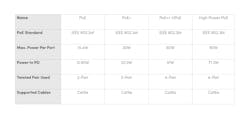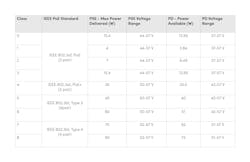What Is IEEE 802.3bt Hi-PoE and How To Use It to Its Full Potential
Power over Ethernet (PoE) technology makes network deployment easier by allowing power and data to be simultaneously transmitted over a live data link via Ethernet cables, eliminating the need for power outlets or electrical wires. PoE system architecture has offered enormous advantages, including simple installation and expansion, reduced operating and capital expenses, and a dependable and secure power standard for all types of networks.
The demand for higher power delivery has grown since ratifying the 802.3af PoE standard (Type 1) in 2003. This evolution led to the development of the most recent PoE standard, the IEEE 802.3bt High Power PoE, or Hi-PoE.
Hi-PoE, capable of providing Powered Devices (PD) with nominal power levels of up to 71.3 watts (W) (100 W from the Power Source Equipment or PSE), represents a significant leap in power delivery, reducing the standby power needed for the powered device.
This white paper explores Hi-PoE in detail and its potential applications, providing insights to improve your network’s reliability, cost efficiency, and scalability while keeping you updated on the latest advancements in the field.
Why Power over Ethernet Hi-PoE? Why Now?
Hi-PoE was ratified in September 2018, coinciding with the Industrial Internet of Things (IIoT) era. Until then, the limited amount of power made available by previous IEEE standards had been the primary issue restricting PoE deployment with new IIoT applications.
While the original IEEE 802.3af PoE's 15.4 W was sufficient for some devices, it fell short for others. For instance, PTZ cameras, robotics, LED lighting, RFID readers, or HD/4K monitors often require more power, particularly PoE-powered devices that support smart buildings and IoT installations. Power dissipation, which refers to the potential power loss in the system, further limits its practicality; an 802.3af PSE can supply 15.4 W per port, yet the PD only receives 12.95 W.
The IEEE approved the 802.3at PoE (Type 2) standard in 2009 to overcome these drawbacks. Also known as PoE+, 802.3at increased wattage to 30 W. As with 802.3af, however, a portion of the 30 W is lost during transmission, leaving just 25.5 W of maximum power at the PD. Network managers were left wanting more.
Enter IEEE 802.3bt.
This standard has Type 3 60 W (PoE++ or UPoE) and Type 4 100 W (Hi-PoE). The chart below compares the four types of PoE.
Unlike 802.3af or 802.3at, which operate on two twisted pairs for power transmission, 802.3bt uses four twisted pairs. Applying eight wires per cable (four pairs) minimizes power loss. IEEE 802.3bt pushes power limits to 100 W, the maximum amount of power that can be delivered on each port as defined by Safety Extra Low Voltage (SELV) requirements for safe and reliable operation.
IEEE 802.3 Support for New Classes
All four types of PoE in IEEE 802.3 are assigned a "class" ranging from 0 to 8. This class system helps to eliminate guesswork and better manage a PSE's power budget. Classes form using the lowest standard power level that the PSE and the PD can support. It is crucial to ensure that devices support PoE for compatibility and efficient power management.
While Type 1 (PoE) and Type 2 (PoE+) support Class 0 to 4, Type 3 (PoE++) supports Class 5 to 6, and Type 4 (Hi-PoE) supports Class 7 to 8. IEEE 802.3bt is backward compatible with 802.3at/af, enabling support for multiple PoE classes.
The chart below shows a PoE power level comparison per class.
Single and Dual Signatures in PoE Standard
In addition to an expanded range of classes, the IEEE 802.3bt standard also introduced new "single" and "dual" signature topologies for PDs.
A single-signature PD has a single detection circuit and a single classification circuit. It shares the same classification, Maintains Power Signature (MPS), and detects signatures during handshakes. In contrast, a dual-signature PIR detector has two separate detection and classification circuits.
Let me explain this with an example.
A dual-signature PIR detector architecture can connect one pair to the camera in a video surveillance application. In contrast, the other PIR detector can connect to a heater or the PTZ motor. There are two types of pair sets, and dual-signature PIR detectors need two parallel interfaces, making this approach more costly. The IEEE 802.3af/at PoE standards cannot distinguish between single-signature PDs and dual-signature ones. However, using a new Connection Check feature, the 802.3bt standard enables the differentiation between these two connected device types.
Another new feature is Autoclass, an optional extension of the physical layer classification. When Autoclass is on, the PSE can determine the maximum power drawn by connected PD devices, enabling more efficient power budgeting. However, Autoclass only works with single-signature PDs. Power sourcing equipment (PSE) delivers power and data through Ethernet cables to connected powered devices (PDs), and it can be categorized into 'endspan' devices, typically network switches, and 'midspan' devices, which serve as intermediaries or external injectors to supply power to non-PoE-capable switches.
Backward Compatibility in IEEE PoE Standards
IEEE 802.3bt is backward compatible with 802.3at and 802.3af PDs, allowing a higher-power 802.3bt PSE to connect trouble-free to a lower-power 802.3at or 802.3af PD. When the roles reverse, and a lower power 802.3at or 802.3af PSE links to a higher power 802.3bt PD, the PD only has to be able to function in the corresponding lower power state. This process, known as 'power demotion', ensures that the PD automatically reduces its power consumption to match the lower power supply available. However, if the PD ignores the power demotion and operates at its highest power state, the DC power PSE will continually turn on, reach its current limit, and turn off repeatedly. For this reason, both 802.3at and 802.3bt require power demotion.
Powered Devices That Benefit From Hi-PoE
Hi-PoE has extended the benefits of lower wattage PoE standards to a new range of power-hungry devices, opening up exciting possibilities. Connected PoE devices are crucial in managing power and ensuring compliance with IEEE PoE standards, preventing damage to non-PD devices. Here's a glimpse of the types of devices that can benefit from Hi-PoE and the exciting opportunities it brings:
- Pan-Tilt-Zoom (PTZ) IP Network Cameras: A motorized PTZ camera, with its higher power consumption, often exceeds the limitations of 802.3/af/at and PoE switches. IEEE 802.3bt PoE, with its high-power PoE switch, provides a practical and reliable solution, ensuring power requirements are met.
- LED Lighting: Hi-PoE Ethernet switches can supply LED lights with up to 90 W of power, reducing facility energy consumption by up to 80% compared to traditional incandescent, fluorescent, or HID lighting sources. Applying the 802.3bt standard lowers the minimum standby power required when the transmit power to an LED luminaire is off. The newest standard reduces minimum standby power to 20 mW, approximately 10 times less than older IEEE standards.
- 802.11ac/ax Wireless Access Points (WAP): Offices, warehouses, factories, and industrial sites that rely on wireless networking frequently deploy high-performance WAPs to allow authorized users to access the network. Newer 802.11 ac/ax WAPs may require more than 60 W to function correctly. These WAPs can be linked to Hi-PoE Ethernet switches to supply needed power. In addition, PoE adds flexibility, whereas WAP can be mounted to achieve the best signal.
- IIoT Sensors: Controlling and collecting data on industrial processes requires sensors that can connect to cloud-based services for remote access. Power consumption depends heavily on sensor features and functions such as onboard data logging, wireless transmitting, and the number of internal electronics drawing power (i.e., transistors, capacitors, ICs, resistors). Next-generation sensors are increasingly complex and demand wattage beyond the limitations of 802.3af/at.
Choosing an 802.3bt Industrial PoE Switch: Compatibility Matters
When upgrading a network infrastructure to take advantage of the IEEE 802.3bt PoE standard, it's critical to consider all the PDs that will be connected and calculate their power requirements to establish a power budget. Ethernet switch and PoE device capabilities are essential when upgrading a network infrastructure for 802.3bt. Ensuring compatibility and compliance with the power over Ethernet (PoE) 802.3bt standard is crucial. The industrial switch and connected PD end equipment must be interoperable and compliant with the 802.3bt standard. Many industrial Ethernet switch manufacturers promote compatibility with the 802.3bt standard but only deliver the Type 3 power level of 60 W. Antaira has implemented the 802.3bt standard to a total of 90 W in its multiple-port Gigabit industrial managed and unmanaged Ethernet switches, Gigabit Type 3 and Type 4 industrial Gigabit injectors, and Ethernet-to-Fiber industrial PoE Media Converters.
About the Author

Henry Martel
Field Applications Engineer, Antaira Technologies
Henry Martel has over 10 years of IT experience along with skills in system administration, network administration, telecommunications, and infrastructure management. He has also been a part of management teams that oversaw the installation of new technologies on public works projects, hospitals, and major retail chains.


